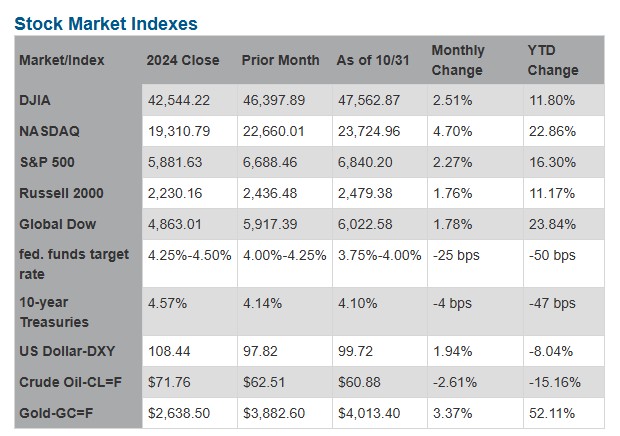November 4, 2025
The Markets (as of market close October 31, 2025)
Wall Street experienced notable volatility in October, only to see each of the benchmark indexes listed here close the month higher. The NASDAQ led the benchmarks, reaching a new record high. This surge was heavily influenced by a surge in AI stocks. Several major tech firms posted favorable corporate earnings data for the third quarter. Overall, the percentage of S&P 500 companies reporting positive earnings surprises, at 83.2% through the third quarter, was above the long-term average. Among the market sectors, information technology, health care, and consumer discretionary moved higher, while financials and consumer staples were among the sectors that underperformed.
In October, the U.S. economy faced slowing job growth, elevated inflation, and a significant monetary policy pivot by the Federal Reserve, which cut interest rates for a second time this year.
The government shutdown has hampered the release of important information, making it difficult to gauge the state of the economy. For instance, labor market data is lacking, as is the latest information on gross domestic product (GDP). The Consumer Price Index was released however, that data was based on information collected prior to the shutdown.
The U.S. bond market in October 2025 was primarily driven by Federal Reserve policy, inflation data, slowing labor market growth, and the impact of a U.S. government shutdown. Ten-year Treasury yields generally moved lower for the month, dropping by about 15 basis points from the start of October, although they bounced back somewhat toward the end of the month.
The month of October 2025 was largely characterized by a bearish trend for crude oil, with prices on track for a third consecutive monthly decline. Oversupply concerns played a large part in the downward movement of crude oil prices. The retail price of regular gasoline was $3.035 per gallon on October 27, $0.083 below the price a month earlier but $0.062 lower than the price a year ago.

Chart reflects price changes, not total return. Because it does not include dividends or splits, it should not be used to benchmark the performance of specific investments.
Eye on the Month Ahead
The primary focus in November will center on when the government shutdown will end and what economic information will be available at that time.
Data sources: Economic: Based on data from U.S. Bureau of Labor Statistics (unemployment, inflation); U.S. Department of Commerce (GDP, corporate profits, retail sales, housing); S&P/Case-Shiller 20-City Composite Index (home prices); Institute for Supply Management (manufacturing/services). Performance: Based on data reported in WSJ Market Data Center (indexes); U.S. Treasury (Treasury yields); U.S. Energy Information Administration/Bloomberg.com Market Data (oil spot price, WTI, Cushing, OK); www.goldprice.org (spot gold/silver); Oanda/FX Street (currency exchange rates). News items are based on reports from multiple commonly available international news sources (i.e., wire services) and are independently verified when necessary with secondary sources such as government agencies, corporate press releases, or trade organizations. All information is based on sources deemed reliable, but no warranty or guarantee is made as to its accuracy or completeness. Neither the information nor any opinion expressed herein constitutes a solicitation for the purchase or sale of any securities, and should not be relied on as financial advice. Forecasts are based on current conditions, subject to change, and may not come to pass. U.S. Treasury securities are guaranteed by the federal government as to the timely payment of principal and interest. The principal value of Treasury securities and other bonds fluctuates with market conditions. Bonds are subject to inflation, interest-rate, and credit risks. As interest rates rise, bond prices typically fall. A bond sold or redeemed prior to maturity may be subject to loss. Past performance is no guarantee of future results. All investing involves risk, including the potential loss of principal, and there can be no guarantee that any investing strategy will be successful.
IMPORTANT DISCLOSURES Camden National Wealth Management does not provide investment, tax, legal, or retirement advice or recommendations. The information presented here is not specific to any individual's personal circumstances. To the extent that this material concerns tax matters, it is not intended or written to be used, and cannot be used, by a taxpayer for the purpose of avoiding penalties that may be imposed by law. Each taxpayer should seek independent advice from a tax professional based on his or her individual circumstances. These materials are provided for general information and educational purposes based upon publicly available information from sources believed to be reliable — we cannot assure the accuracy or completeness of these materials. The information in these materials may change at any time and without notice.
Trust and investment management services are provided by Camden National Bank, a national bank with fiduciary powers. Camden National Bank is a wholly owned subsidiary of Camden National Corporation. Camden National Bank does not provide tax, accounting or legal advice. Please consult your accountant and/or attorney for tax and legal advice.
Investment solutions such as stocks, bonds and mutual funds are:
"NOT A DEPOSIT • NOT FDIC INSURED • NOT GUARANTEED BY THE BANK • NOT INSURED BY ANY FEDERAL GOVERNMENT AGENCY • MAY LOSE VALUE"
